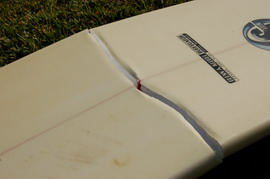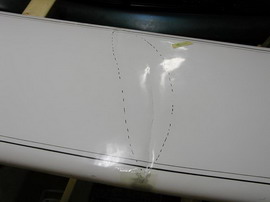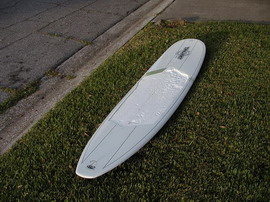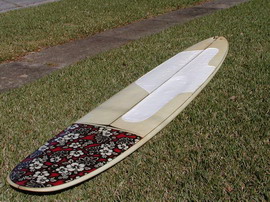| This series covers both major and minor surfboard repair situations. Someday I'll re-arrange the ordering, but for the time being you should probably begin with Board #6 which covers small to medium board repairs unless you are specifically looking for information on fixing a broken board. Even if you don't plan to attempt repairs like this yourself, it always helps to understand more about the processes required to complete a major repair. The most significant issues that should concern you are increases in weight and rigidity of the board. Concerns about what a repair looks like or how strong it will be should take a back seat compared to concerns of how it will change the original weight and rigidity of the board, thus impacting performance. Read on. Note that I am an engineer, not a surfboard repair man. I don't fix surfboards for a living. Between me, my kids, and their friends we break enough boards to keep me as busy as I care to be. |
 Board #1 The basics - broken board repair - start here. |
|
 Board #3 Double buckle of a 9'6" epoxy board. |
|
|
|
|
Why would you want to repair your own board? It is not overly expensive to have a broken board repaired. However, finding a good repair man may be difficult. For surfboard industry occupations, surfboard repair is probably near the bottom of the rung. Few people aspire to be surfboard repair specialist. Also, I have waited over 3 months to get my board back from the shop more than once. A repair shop will often fix your board the fastest way, with the goal to make it look nice, but they may not pay a lot of attention to how much weight or rigidity they add to the board. In general, I think the prevalent view is that once you break a board, that's the end of its top performance life, and anyone who is serious about their surfing is just going to buy another board. My view is that it you fix it right, you won't notice the difference. Thus, I think $100 or less spent to properly repair an $800+ surfboard is a good investment. The actual material costs is not very high, but it takes a lot of labor. So, not only do you save some money, you have the chance of getting back in the water a lot sooner. And, if you do a good job, you may end up with a repair as good or better than you would get back from a shop. On the other hand, make no mistake, I highly advise that most people are far better off taking their board to a good shop than doing the repair themselves! It takes some special skills and the right aptitude to do a good repair. In short, home repair of broken boards is probably a task best left to fanatics like me that break several boards a year and view surfboard repair sort of like they view mowing the lawn - something that needs to be done but isn't very much fun. A good source for additional information is the series: How to Build Your First Surfboard. |

